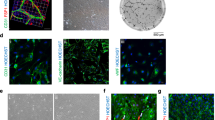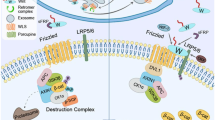Abstract
Cell transplantation is a promising new modality in treating damaged myocardium after myocardial infarction and in preventing postmyocardial infarction LV remodelling. Two strategies are plausible: the first uses adult tissue stem cells to replace the scar tissues and amend the lost myocardium, whilst the second strategy uses embryonic stem cells in an attempt to regenerate myocardium and/or blood vessels.
Similar content being viewed by others
References
Abbate A et al (2002) Persistent infarct-related artery occlusion is associated with an increased myocardial apoptosis at postmortem examination in humans late after an acute myocardial infarction. Circulation 106:1051–1054
Alison MR et al (2000) Hepatocytes from non-hepatic adult stem cells. Nature 406:257
Allsopp RC et al (2001) Telomere length predicts replicative capacity of human fibroblasts. Proc Natl Acad Sci USA 89:10114–10118
Almsherqi ZA et al (2002) Bone marrow-derived stem cell transplantation into the heart of patients undergoing coronary artery bypass surgery, abstract presented at the 14th Annual Scientific Meeting, Singapore Cardiac Society, p. 34
Asahara T et al (1997) Isolation of putative progenitor endothelial cells for angiogenesis. Science 275:964–967
Asahara T et al (1999) Bone marrow origin of endothelial progenitor cells responsible for postnatal vasculogenesis in physiological and pathological neovascularization. Circ Res 85:221–228
Bittner RE et al (1999) Recruitment of bone-marrow-derived cells by skeletal and cardiac muscle in adult dystrophic mdx mice. Anat Embryol (Berl) 199:391–396
Bjornson CR et al (1999) Turning brain into blood: a hematopoietic fate adopted by adult neural stem cells in vivo. Science 283:534–537
Blau HM, Baltimore D (1991) Differentiation requires continuous regulation. J Cell Biol 112:781–783
Blau HM et al (2001) The evolving concept of a stem cell: entity or function? Cell 105:829–841
Bodnar AG et al (1998) Extension of life-span by introduction of telomerase into normal human cells. Science 279:349–352
Boheler KR, Wobus AM (2002) Myocardial aging and stem cell biology. In: Mattson MP, van Zant G (eds) Stem cells: a cellular fountain of youth? Elsevier Science, New York, pp 141–177
Boheler KR et al (2002) Differentiation of pluripotent embryonic stem cells into cardiomyocytes. Circ Res 91:189–201
Bongso A et al (1994) Isolation and culture of inner cell mass cells from human blastocysts. Hum Reprod 9:2110–2117
Brazelton TR et al (2000) From marrow to brain: expression of neuronal phenotypes in adult mice. Science 290:1775–1779
Chiu RC (1995) Dynamic cardiomyoplasty for heart failure. Br Heart J 73:1–3
Chiu RC et al (1995) Cellular cardiomyoplasty: myocardial regeneration with satellite cell implantation. Ann Thorac Surg 60:12–18
Counter CM (1996) The roles of telomeres and telomerase in cell life span. Mutat Res 366:45–63
Ebrahim GJ (2002) Umbilical cord blood—a rich source of haematopoietic stem cells. J Trop Pediatr 48:64–65
Eglitis MA, Mezey E (1997) Hematopoietic cells differentiate into both microglia and macroglia in the brains of adult mice. Proc Natl Acad Sci USA 94:4080–4085
El Oakley RM et al (2001) Myocyte transplantation for myocardial repair: a few good cells can mend a broken heart. Ann Thorac Surg 71:1724–1733
El Okley RM, Jarvis JC (1994) Cardiomyoplasty; a critical review of experimental and clinical results. Circulation 90(4):2085–2090.
El Oakley RM et al (2005) Transplantation of autologous bone marrow-derived cells into the myocardium of patients undergoing coronary bypass. Heart Surg Forum 8(5):348–350
El Oakley RM et al (2002) Whole bone marrow transplantation induces angiogenesis following acute ischemia. Redox Report 7:1–4
EMERAS (Estudio Multicentrico Estreptoquinasa Republicas de America del Sur) Collaborative Group (1993) Randomised trial of late thrombolysis in patients with suspected acute myocardial infarction. Lancet 342(8874):767–772
Ferrari G et al (1998) Muscle regeneration by bone marrow-derived myogenic progenitors. Science 279:1528–1530
Gale RP (1995) Cord-blood-cell transplantation—a real sleeper? N Engl J Med 332:392–394
Gluckman E et al (1999) Peripheral stem cells in bone marrow transplantation. Cord blood stem cell transplantation. Baillieres Best Pract Res Clin Haematol 12:279–292
Gussoni E et al (1999) Dystrophin expression in the mdx mouse restored by stem cell transplantation. Nature 401:390–394
Hamano K et al (2001) Local implantation of autologous bone marrow cells for therapeutic angiogenesis in patients with ischemic heart disease. Jpn Circ J 65:845–847
Hescheler J et al (1997) Embryonic stem cells: a model to study structural and functional properties in cardiomyogenesis. Cardiovasc Res 36:149–162
Hescheler J et al (1999) Establishment of ionic channels and signalling cascades in the embryonic stem cell-derived primitive endoderm and cardiovascular system. Cells Tissue Organ 165:153–164
Hutcheson KA et al (2000) Comparison of benefits on myocardial performance of cellular cardiomyoplasty with skeletal myoblasts and fibroblasts. Cell Transplant 9:359–368
Jackson KA et al (1999) Hematopoietic potential of stem cells isolated from murine skeletal muscle. Proc Natl Acad Sci USA 96:14482–14486
Jackson KA et al (2001) Regeneration of ischemic cardiac muscle and vascular endothelium by adult stem cells. J Clin Invest 107:1395–1402
Jiang Y et al (2002a) Multipotent progenitor cells can be isolated from postnatal murine bone marrow, muscle, and brain. Exp Hematol 30:896
Jiang Y et al (2002b) Pluripotency of mesenchymal stem cells derived from adult marrow. Nature 418:41–49
Kehat I et al (2001) Human embryonic stem cells can differentiate into myocytes with structural and functional properties of cardiomyocytes. J Clin Invest 108:407–414
Kipling D (2001) Telomeres, replicative senescence and human ageing. Maturitas 38:25–37
Klug MG et al (1996) Genetically selected cardiomyocytes from differentiating embryonic stem cells form stable intracardiac grafts. J Clin Invest 98:216–224
Krause DS et al (2001) Multi-organ, multi-lineage engraftment by a single bone marrow-derivedstem cell. Cell 105:369–377
Lagasse E et al (2000) Purified hematopoietic stem cells can differentiate into hepatocytes in vivo. Nat Med 6:1229–1234
Lazarus HM et al (1995) Ex vivo expansion and subsequent infusion of human bone marrow-derived stromal progenitor cells (mesenchymal progenitor cells): implications for therapeutic use. Bone Marrow Transplant 16:557–564
Mackin W et al (2001) The frontier of cellular medicine: expanding umbilical cord blood stem cells for clinical use. Cancer J 7(Suppl 2):S95–S105
Magovern GJ, Simpaon KA (1996) Clinical cardiomyoplasty: review of the ten-year United States experience. Ann Thorac Surg 61:413–419
Makino S et al (1999) Cardiomyocytes can be generated from marrow stromal cells in vitro. J Clin Invest 103:697–705
Menasché P et al (2001a). Myoblast transplantation for heart failure. Lancet 357:279–280
Menasché P et al (2001b) Early results of autologous skeletal myoblast transplantation in patients with severe ischemic heart failure, American Heart Association scientific conference Abstract ID 101052. Publishing ID 2830
Metzger JM et al (1997) Embryonic stem cell cardiogenesis: applications for cardiovascular research. Trends Cardiovasc Med 7:63–68
Mezey E et al (2000) Turning blood into brain: cells bearing neuronal antigens generated in vivo from bone marrow. Science 290:1779–1782
Murry C et al (1996) Skeletal myoblast transplantation for repair of myocardial necrosis. J Clin Invest 98:2512–2523
Odorico JS et al (2001) Multilineage differentiation from human embryonic stem cell lines. Stem Cells 19:193–204
Oh H, Schneider MD (2002) The emerging role of telomerase in cardiac muscle cell growth and survival. J Mol Cell Cardiol 34:717–724
Orlic D (2001) Transplanted adult bone marrow cells repair myocardial infarcts in mice. Ann NY Acad Sci 938:221–229
Orlic D et al (2001) Bone marrow cells regenerated infracted myocardium. Nature 410:701–705
Pereira RF (1995) Cultured adherent cells from marrow can serve as long-lasting precursor cells for bone, cartilage, and lung in irradiated mice. Proc Natl Acad Sci USA 92:4857–4861
Petersen BE et al (1999) Bone marrow as a potential source of hepatic oval cells. Science 284:1168–1170
Reinecke H et al (1999) Survival, integration, and differentiation of cardiomyocyte grafts: a study in normal and injured rat hearts. Circulation 100:193–202
Reyes M, Verfaillie CM (2001) Characterization of multipotent adult progenitor cells, a subpopulation of mesenchymal stem cells. Ann NY Acad Sci 938:231–233
Reyes M et al (2001) Purification and ex vivo expansion of postnatal human marrow mesodermal progenitor cells. Blood 98:2615–2625
Reyes M et al (2002) Origin of endothelial progenitors in human postnatal bone marrow. J Clin Invest 109:337–346
Richards M et al (2002) Human feeders support prolonged undifferentiated growth of human inner cell masses and embryonic stem cells. Nat Biotechnol 20:933–936
Roell W et al (2002) Cellular cardiomyoplasty improves survival after myocardial injury. Circulation 105:2435–2441
Sakai T et al (1999) Fetal cell transplantation: a comparison of␣three cell types. J Thorac Cardiovasc Surg 118:715–724
Schuldiner M et al (2000) Effects of eight growth factors on the differentiation of cells derived from human embryonic stem cells. Proc Natl Acad Sci USA 97:11307–11312
Schwartz et al. (2002) Multipotent adult progenitor cells from bone marrow differentiate into functional hepatocyte-like cells. J Clin Invest 109:1291–1302
Scorsin M et al (2000) Comparison of the effects of fetal cardiomyocyte and skeletal myoblast transplantation on postinfarction left ventricular function. J Thoracic Cardiovasc Surg 119:1169–1175
Shamblott MJ et al (1998) Derivation of pluripotent stem cells from cultured human primordial germ cells. Proc Natl Acad Sci USA 10:95
Shi Q et al (1998) Evidence for circulating bone marrow-derived endothelial cells. Blood 92:362–367
Siminiak T et al (2002) Myoblast transplantation in the treatment of postinfarction myocardial contractility impairment—a case report. Kardiol Pol 56:131
Stamm C et al (2002) Bone marrow stem cell transplantation for regeneration of infracted myocardium in CABG patients, Abstract presented at the 16th Annual Meeting of the EACTS, p 570
Strauer B et al (2002) Repair of infracted myocardium by autologous intracoronary mononuclear bone marrow cell transplantation in humans. Circulation 106:1913–1918
Strauer BE et al (2005) Regeneration of Human Infarcted Heart Muscle by Intracoronary Autologous Bone Marrow Cell Transplantation next term in Chronic Coronary Artery Disease. J Am Coll Cardiol 46(9):1651–1658
Szilvassy S et al (1999) Organ-selective homing defines engraftment kinetics of murine hematopoietic stem cells and is compromised by ex vivo expansion. Blood 93:1557–1566
Taylor DA et al (1998) Regenerating functional myocardium: improved performance after skeletal myoblast transplantation. Nat Med 4:929–933
Theise ND et al (2000a) Liver from bone marrow in humans. Hepatology 32:11–16
Theise ND et al (2000b) Derivation of hepatocytes from bone marrow cells in mice after radiation-induced myeloablation. Hepatology 31:235–240
Thompson C (1995) Umbilical cords: turning garbage into clinical gold. Science 268:805–806
Thomson JA et al (1998) Embryonic stem cell lines derived from human blastocysts. Science 282:1145–1147
Toma C et al (2002) Human mesenchymal stem cells differentiate to a cardiomyocyte phenotype in the adult murine heart. Circulation 105:93–98
Tomita S et al (1999) Autologous transplantation of bone marrow cells improves damaged heart function. Circulation 100(19 Suppl):II247–II256
Wilmut I et al (1997) Viable offspring derived from fetal and adult mammalian cells. Nature 385:810–813
Yoo KJ et al (2000) Autologous smooth muscle cell transplantation improved heart function in dilated cardiomyopathy. Ann Thorac Surg 70:859–865
Zhao LR et al (2002) Human bone marrow stem cells exhibit neural phenotypes and ameliorate neurological deficits after grafting into the ischemic brain of rats. Exp Neurol 174:11–20
Author information
Authors and Affiliations
Corresponding author
Rights and permissions
About this article
Cite this article
Ooi, O.C., Al Habib, H., Almsherqi, Z.A. et al. Stem cell transplantation: potential impact on heart failure. Cell Tissue Banking 7, 307–317 (2006). https://doi.org/10.1007/s10561-006-9007-y
Received:
Accepted:
Published:
Issue Date:
DOI: https://doi.org/10.1007/s10561-006-9007-y




